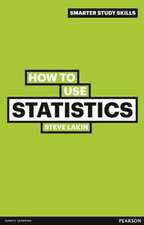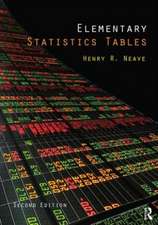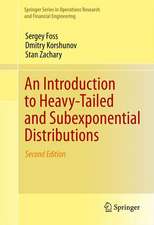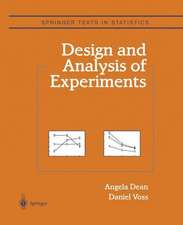Quantitative Methods for Current Environmental Issues
Editat de Clive W. Anderson, Vic Barnett, Philip C. Chatwin, Abdel H. El-Shaarawien Limba Engleză Paperback – 14 sep 2011
It brings together distinguished scientists and engineers to present the most up-to-date and practical methods for quantitative measurement and prediction and is organised around four themes:
- spatial and temporal models and methods;
- environmental sampling and standards;
- atmosphere and ocean;
- risk and uncertainty.
Quantitative Methods for Current Environmental Issues is an invaluable resource for statisticians, applied mathematicians and researchers working on environmental problems, and for those in government agencies and research institutes involved in the analysis of environmental issues.
Preț: 387.58 lei
Nou
Puncte Express: 581
Preț estimativ în valută:
74.16€ • 77.63$ • 61.73£
74.16€ • 77.63$ • 61.73£
Carte tipărită la comandă
Livrare economică 31 martie-14 aprilie
Preluare comenzi: 021 569.72.76
Specificații
ISBN-13: 9781447111719
ISBN-10: 1447111710
Pagini: 284
Ilustrații: X, 270 p.
Dimensiuni: 155 x 235 x 15 mm
Greutate: 0.4 kg
Ediția:Softcover reprint of the original 1st ed. 2002
Editura: SPRINGER LONDON
Colecția Springer
Locul publicării:London, United Kingdom
ISBN-10: 1447111710
Pagini: 284
Ilustrații: X, 270 p.
Dimensiuni: 155 x 235 x 15 mm
Greutate: 0.4 kg
Ediția:Softcover reprint of the original 1st ed. 2002
Editura: SPRINGER LONDON
Colecția Springer
Locul publicării:London, United Kingdom
Public țintă
ResearchDescriere
It is increasingly clear that good quantitative work in the environmental sciences must be genuinely interdisciplinary. This volume, the proceedings of the first combined TIES/SPRUCE conference held at the University of Sheffield in September 2000, well demonstrates the truth of this assertion, highlighting the successful use of both statistics and mathematics in important practical problems.
It brings together distinguished scientists and engineers to present the most up-to-date and practical methods for quantitative measurement and prediction and is organised around four themes:
- spatial and temporal models and methods;
- environmental sampling and standards;
- atmosphere and ocean;
- risk and uncertainty.
Quantitative Methods for Current Environmental Issues is an invaluable resource for statisticians, applied mathematicians and researchers working on environmental problems, and for those in government agencies and research institutes involved in the analysis of environmental issues.
It brings together distinguished scientists and engineers to present the most up-to-date and practical methods for quantitative measurement and prediction and is organised around four themes:
- spatial and temporal models and methods;
- environmental sampling and standards;
- atmosphere and ocean;
- risk and uncertainty.
Quantitative Methods for Current Environmental Issues is an invaluable resource for statisticians, applied mathematicians and researchers working on environmental problems, and for those in government agencies and research institutes involved in the analysis of environmental issues.
Cuprins
I. Spatial and Temporal Models and Methods.- 1 Modeling Spatio-Temporally Misaligned Areal and Point Process Environmental Data.- 1.1 Introduction.- 1.2 Misaligned Areal Data Model Development.- 1.3 Example: Radon Exposure near an Ohio Contamination Source.- 1.4 Misaligned Point-Block Data Model Development.- 1.5 Example: Ozone Exposure by Zip Code in Atlanta.- 1.6 Summary and Discussion.- References.- 2 Space and Space-Time Modeling using Process Convolutions.- 2.1 Introduction.- 2.2 Constructing Spatial Models via Moving Averages.- 2.3 Basic Spatial Model.- 2.4 A Multiresolution Model.- 2.5 Building Space-Time Models.- 2.6 Discussion.- References.- 3 Multivariate Kriging for Interpolating with Data from Different Sources.- 3.1 Introduction.- 3.2 Data from Different Sources.- 3.3 Simple and Ordinary Cokriging.- 3.4 Cokriging with External Drifts.- 3.5 Cokriging Neighborhood.- 3.6 Ebro Case Study.- References.- II. Environmental Sampling and Standards.- 4 Distance Sampling: Recent Advances and Future Directions.- 4.1 Introduction.- 4.2 Standard Distance Sampling Methods.- 4.3 Covariate Models for the Detection Function.- 4.4 Double-Platform Methods.- 4.5 Spatial Distance Sampling Models.- 4.6 Indirect Distance Sampling Surveys.- 4.7 Automated Design Algorithms.- 4.8 Adaptive Distance Sampling.- 4.9 The Software Distance.- 4.10 State-Space Models for Trend.- 4.11 Discussion.- References.- 5 Setting Environmental Standards: A Statistical Approach.- 5.1 Background.- 5.2 Setting a Statistically Verifiable Ideal Standard.- 5.3 A Best Linear Unbiased Quantile Estimator.- 5.4 Example: Copper Levels in River Water.- 5.5 Conclusion.- References.- III. Atmosphere and Ocean.- 6 The Interpretation and Validation of Measurements of the Ocean Wave Directional Spectrum.- 6.1 Introduction.- 6.2 The Statistical Description of the Sea Surface.- 6.3 Measurement Techniques.- 6.4 Validation/Intercomparison Issues.- 6.5 Methods Used and their Application.- 6.6 Concluding Remarks.- References.- 7 Thermal Energy Emission and Propagation from Accidents.- 7.1 Introduction.- 7.2 Heat Transfer Theory.- 7.3 Global Radiative Model Architecture and Application.- 7.4 Comments on Model Results.- 7.5 Conclusions.- References.- 8 Development and Application of an Extended Methodology to Validate Short-Range Atmospheric Dispersion Models.- 8.1 Introduction.- 8.2 Model Validation Tool.- 8.3 Descriptions of Dispersion Models Tadmod and Tstep.- 8.4 Results and Discussion.- 8.5 Conclusions.- Appendices.- References.- 9 Uncertainty and Sensitivity of Dispersion Model Results to Meteorological Inputs: Two Case Studies.- 9.1 Introduction.- 9.2 Model Evaluation and Sensitivity Study with Dipole Pride 26.- 9.3 Persian Gulf War Exposure Study.- 9.4 Conclusions.- References.- IV. Risk and Uncertainty.- 10 Statistics and the Environmental Sciences: Approaches to Model Combination.- 10.1 Introduction.- 10.2 Statistical Framework.- 10.3 Examples.- 10.4 Discussion.- References.- 11 Bayesian Analysis of Computer Code Outputs.- 11.1 Analysis of Computer Code Outputs.- 11.2 Bayesian Methods.- 11.3 Windscale Nuclear Accident.- 11.4 Discussion.- References.- 12 The Realities of Decision Making on Risks.- 12.1 Introduction.- 12.2 Decision Making on Health and Safety.- 12.3 Changing Nature of Risk Debates.- 12.4 Changing Influence of Science.- 12.5 Public Responses to Risk Issues.- 12.6 Features of the Public Debate on Risk Decision Making.- 12.7 Risk-Based Approach to Regulation.- 12.8 Risk Assessment.- 12.9 Strengths and Limitations of Risk Assessment.- 12.10 Concluding Remarks.- References.
Caracteristici
Features the most recent quantitative methods for studying environmental issues
Includes contributions from the foremost researchers in the field
Includes contributions from the foremost researchers in the field

















